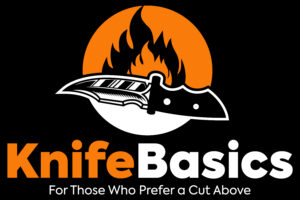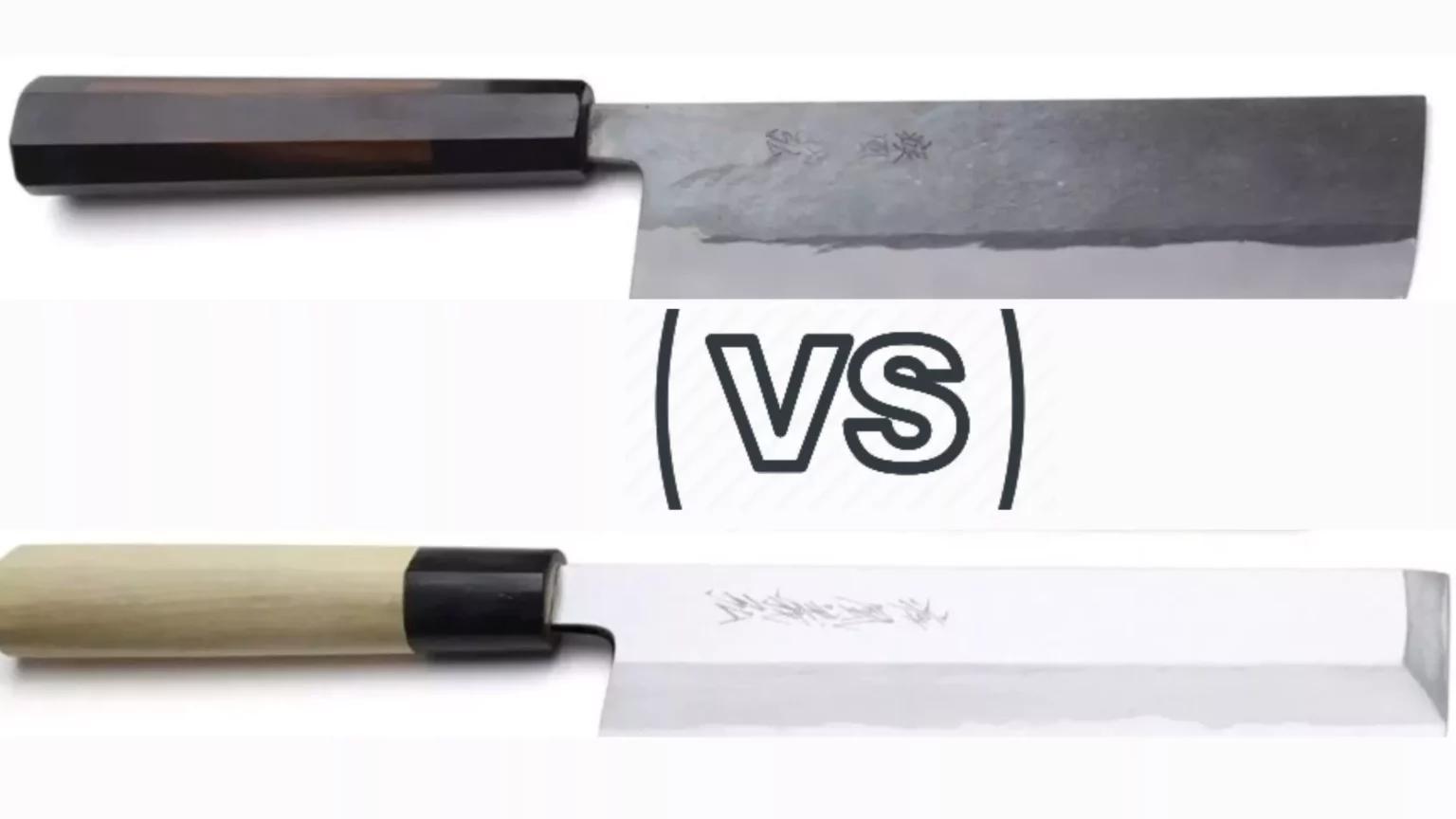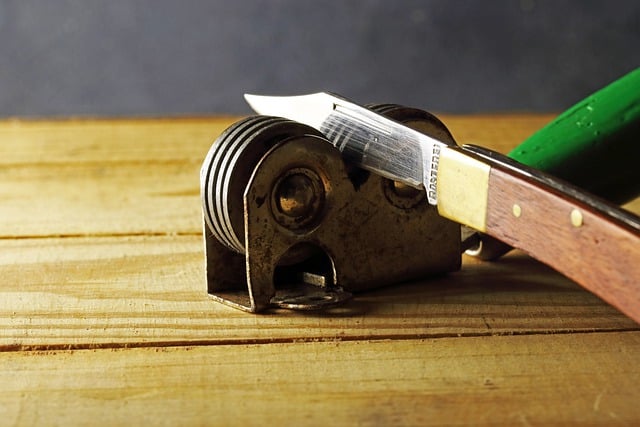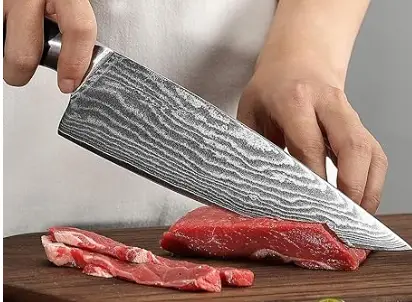From a casual glance, Nakiri and Usuba knives appear identical. Distinguishing one from the other can be difficult as they feature almost the same length and same blade styling.
The main difference between a Nakiri Knife and an Usuba knife is that a Nakiri knife features a double bevel edge and has a flat tip design, while an Usuba knife features a single bevel edge and may have either a flat tip or curved tip design.
We’ll go over each of these two vegetable knives in more detail to help you understand each knife’s features and functionality.
Nakiri Knife
The word Nakiri comes from the traditional Japanese chef knife’s duties. The word ‘na’ means leaf, while ‘kiri’ means to cut. Nakiri is basically a vegetable knife that can slice, chop and mince vegetables

Nakiri knife Use
The Nakiri knife is ideal for those who enjoy salads, soups, and vegetables. In addition, the Nakiri knife is ideal for vertically chopping vegetables. The knife’s design is perfect for this function because it provides extra room for your knuckles.
Features
The Nakiri knife features a straight blade with a flat front and no tip that spans around 6-7 inches in length. It also has a razor-sharp, thick, and highly robust blade. The length between the spine and edge is also big making it suitable to cut through huge chunks of veggies.
The ergonomics form provides the comfort of movement by perfectly balancing the handle and the thin blade at the pinch point. The handle of the Nakiri knife fits nicely in your hand and provides excellent balance.
Its edge is sharpened on both sides, making it suitable for usage by both left and right-handed people. The Nakiri, like most Japanese-style knives, is famous for functioning flawlessly. While it’s reasonable to say that the Nakiri knife is an excellent all-around culinary tool, it’s far from ideal for work with bones or heavy-duty chopping.
Usuba knife
Usuba means “thin blade” in Japanese, which pretty much sums up the purpose of this vegetable knife. The Usuba knife is favoured by professional chefs for its paper-thin slices but has seen a growing trend in home use lately.

Usuba Knife use
The Usuba is a one-sided kitchen knife whose primary function is to make fine vegetable slices. Usuba knives can be found in two different shapes, one with a flat tip and one with a curved tip.
Slicing raw vegetables with the Usuba knife is a breeze. The small, ultra-sharp one-sided blade cuts the surfaces with very little cellular damage, which helps preserve the veggies’ flavor while keeping the cut vegetables fresh for longer.
However, you should avoid using the Usuba on veggies with thicker skins since it would likely harm or bend their thin and delicate edges, which can be extremely difficult to sharpen.
Features
The Usuba knife is usually 6-9 inches in length. With a single bevel blade, the knife is sharpened on one side and is extremely thin and sharp.
Since it’s a single bevel, you, therefore, have to choose a model that fits your hand, whether you have a left or right hand. In addition, this knife has a flat blade with a straight edge that is perfect for precise push-cutting on the board while chopping. You’ll also have a lot of control over the cuts you make.
The traditional Japanese handle and the Western-style handle are the Usuba Knife handles. The majority of Usuba knives have a traditional wooden handle. While some people like the ergonomic grip of a D-shaped handle, it is a matter of personal preference.
Nakiri Knife vs Usuba Knife
Similarities between Nakiri and Usuba
Use: Both Nakiri and Usuba knives are perfect for chopping and slicing vegetables. None of the knives can deal with tough cutting tasks like cutting bones.
Blade length: Both knives have a long enough blade to chop and slice most vegetables. They also produce clean-cut vegetables with no threads. Both Nakiri and Usuba lack a substantial tip due to their flat edge design.
Easy to cut: Both the knives have blades that cut with precision, no need to keep pushing the blade down. The blade edge is flat hence always in contact with the veggies and you don’t have to make a rocking motion to make cuts.
Safe: Both of them feature a long flat design which makes it safer during cutting as your knuckles are not on the way during cutting. Chances of slippage and slicing are minimal compared to other chef knives.
| FEATURES | NAKIRI KNIFE | USUBA KNIFE |
|---|---|---|
| Bevel | Double Bevel | Single Bevel |
| Hand Use | Ambidextrous | One-Sided (Either Right or Left-handed) |
| Handle | Western or Traditional Japanese | Traditional Japanese |
| Length | 6″-7″ Inches | 6″-9″ Inches |
| Blade Edge | Robust Edge | Extremely Thin and Delicate |
| Cuts | Flexible (large or thin) | Paper-thin slices, decorative cutting tasks |
| Blade Shape | Flat Tip Blade | Flat or Curved Tip Blade |
| Sharpening | Easy Sharpening | Difficult Sharpening |
| Made for | Everyone | Skilled Chefs |
| Price | Comparatively Low | Considerably Higher |
Differences between Nakiri and Usuba
Use: The Nakiri knife is a general volume processor for your vegetables, while the Usuba knife is perfect for fine and decorative vegetable cutting operations, such as salad preparation.
In addition, the Usuba knife has a more delicate thinner, and sharper blade than the Nakiri knife. Nakiri knife may be used on vegetables with thick skin, such as eggplants and squash, whereas the Usuba knife is not suitable for those with thick skin.
Nature of the blade: The Nakiri has a double bevel, whereas the Usuba is sharpened on one side only; this is primarily the major difference between the two knives. Sharpening a single bevel Usuba knife is more challenging than sharpening a double-bevel Nakiri knife.
Right or left-hand use: Because the Usuba knife is single-sided, it is referred to as a ‘handed’ knife, whereas the Nakiri favors both right- and left-handed people. The majority of Usuba knives are right-handed. Usuba knives for left-handed people are extremely rare, and they’re usually created to order.
Handle: The Usuba knife has maintained its Japanese roots and primarily features the prominent traditional Japanese D shape style handle (Wa-Handle). Nakiri on the other hand can be found in both traditional Japanese handles and western-style handles like those found in Western chef knives.
Blade Design: While a Nakiri comes in only one flat design on the tip, an Usuba may feature both a flat design on the tip or a curved tip. The flat blunt tip design Usuba is referred to as Edo-Usuba while the curved spine tip Usuba is referred to as Kamagata Usuba.
Weight: The Nakiri knife tends to always be lighter than the Usuba knife. The Usuba is weighted to enable great balance for professional thin slices.
Price: Usuba knives tend to be more highly-priced than Nakiri knives even when they both feature the same blade steel and handle. This difference can be attributed to the craftsmanship that goes into making the ultra-thin single bevel edge.
Which one should you buy?
The above comparison will help you decide which of these two Japanese vegetable knives is better for you.
The Nakiri is more of an all-arounder and volume cutter for chopping vegetables. The Usuba, on the other hand, is a more delicate, professional Japanese vegetable knife whose primary speciality is producing fine delicate cuts.
The Usuba single bevel edge is extremely sharp and will be better at providing paper-thin slices. However, the single bevel edge has a learning curve and you will have to get used to using it.
You will also have a harder time sharpening the Usuba knife unless you are skilled in sharpening single bevel knives. For these reasons, my preference would be the Nakiri knife, it is not as thin as an Usuba, but it can handle small to large vegetables and will be easier to use and sharpen.
Conclusion
Both Nakiri and Usuba knives are great Japanese knives that perform exceptionally well. Your choice of the knife will depend on how you want to use it and your level of expertise. Nakiri knife is your perfect general-purpose knife. Usuba is a professional knife that requires higher handling and sharpening skills.



